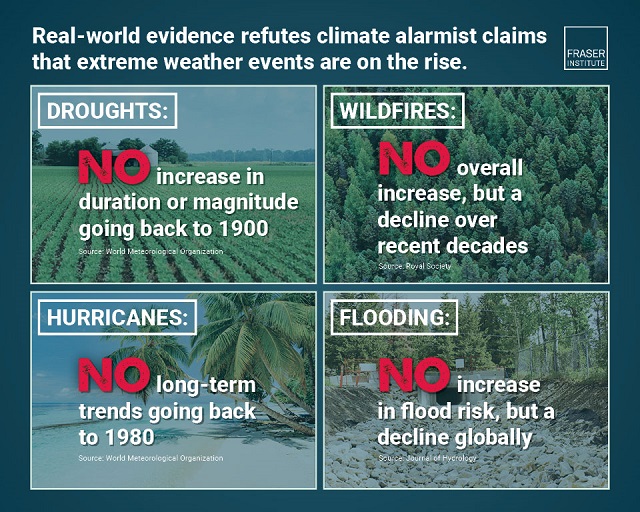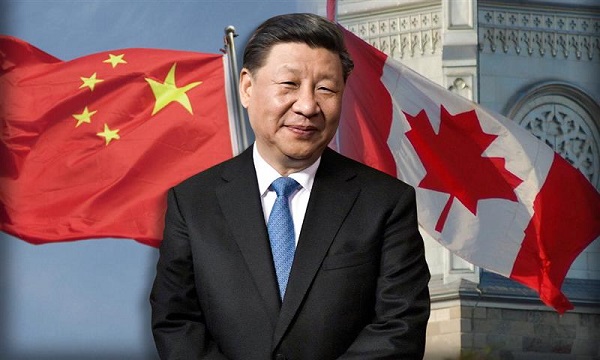Economy
Extreme Weather and Climate Change

From the Fraser Insitute
Contrary to claims by many climate activists and politicians, extreme weather events—including forest fires, droughts, floods and hurricanes—are not increasing in frequency or intensity, finds a new study published today by the Fraser Institute, an independent, non-partisan Canadian public policy think-tank.
“Earth Day has become a time when extraordinary claims are made about extreme weather events, but before policymakers act on those extreme claims—often with harmful regulations—it’s important to study the actual evidence,” said Kenneth Green, a senior fellow with the Fraser Institute and author of Extreme Weather and Climate Change.
The study finds that global temperatures have increased moderately since 1950 but there is no evidence that extreme weather events are on the rise, including:
• Drought: Data from the World Meteorological Organization Standardized Precipitation Index showed no statistically significant trends in drought duration or magnitude—with the exception of some small regions in Africa and South America—from 1900 to 2020.
• Flooding: Research in the Journal of Hydrology in 2017, analyzing 9,213 recording stations around the world, found there were more stations exhibiting significant decreasing trends (in flood risk) than increasing trends.
• Hurricanes: Research conducted for the World Meteorological Organization in 2019 (updated in 2023) found no long-term trends in hurricanes or major hurricanes recorded globally going back to 1980.
• Forest Fires: The Royal Society in London, in 2020, found that when considering the total area burned at the global level, there is no overall increase, but rather a decline over the last decades. In Canada, data from Canada’s Wildland Fire Information System show that the number of fires and the area burned in Canada have both been declining over the past 30 years.
“The evidence is clear—many of the claims that extreme weather events are increasing are simply not empirically true,” Green said.
“Before governments impose new regulations or enact new programs, they need to study the actual data and base their actions on facts, not unsubstantiated claims.”
- Assertions are made claiming that weather extremes are increasing in frequency and severity, spurred on by humanity’s greenhouse gas emissions.
- Based on such assertions, governments are enacting ever more restrictive regulations on Canadian consumers of energy products, and especially Canada’s energy sector. These regulations impose significant costs on the Canadian economy, and can exert downward pressure on Canadian’s standard of living.
- According to the UN IPCC, evidence does suggest that some types of extreme weather have become more extreme, particularly those relating to temperature trends.
- However, many types of extreme weather show no signs of increasing and in some cases are decreasing. Drought has shown no clear increasing trend, nor has flooding. Hurricane intensity and number show no increasing trend. Globally, wildfires have shown no clear trend in increasing number or intensity, while in Canada, wildfires have actually been decreasing in number and areas consumed from the 1950s to the present.
- While media and political activists assert that the evidence for increasing harms from increasing extreme weather is iron-clad, it is anything but. In fact, it is quite limited, and of low reliability. Claims about extreme weather should not be used as the basis for committing to long-term regulatory regimes that will hurt current Canadian standards of living, and leave future generations worse off.
Author:
The Fraser Institute is an independent Canadian public policy research and educational
organization with offices in Vancouver, Calgary, Toronto, and Montreal and ties to a global
network of think-tanks in 87 countries. Its mission is to improve the quality of life for Canadians,
their families and future generations by studying, measuring and broadly communicating the
effects of government policies, entrepreneurship and choice on their well-being. To protect the
Institute’s independence, it does not accept grants from governments or contracts for research.
Visit www.fraserinstitute.org
2025 Federal Election
Fight against carbon taxes not over yet

As the federal government removes the consumer carbon tax, the Canadian Taxpayers Federation is calling on all party leaders to oppose all carbon taxes, including the hidden tax on business.
“Canadians fought hard to force Ottawa to back down on its consumer carbon tax and now the fight moves to stopping the hidden carbon tax on business,” said Franco Terrazzano, CTF Federal Director. “Canadians can’t afford a carbon tax on business that pushes up prices at the gas station and makes it harder for our businesses to compete while they’re already struggling with a trade war.”
Today, the federal government cut the consumer carbon tax rate to $0. This will reduce taxes by about 17 cents per litre of gasoline, 21 cents per litre of diesel and 15 cents per cubic metre of natural gas.
The federal government still imposes an industrial carbon tax on oil and gas, steel and fertilizer businesses, among others.
During the Liberal Party leadership race, Prime Minister Mark Carney said he would “improve and tighten” the industrial carbon tax and “extend the framework to 2035.”
Just 12 per cent of Canadians believe businesses pay most of the cost of the industrial carbon tax, according to a Leger poll commissioned by the CTF. Meanwhile, 70 per cent said businesses would pass most or some carbon tax costs on to consumers.
Conservative Party Leader Pierre Poilievre said he will “repeal the entire carbon tax law, including the tax on Canadian businesses and industries.”
“Carbon taxes on refineries make gas more expensive, carbon taxes on utilities make home heating more expensive and carbon taxes on fertilizer plants increase costs for farmers and that makes groceries more expensive,” Terrazzano said. “Canadians know Poilievre will end all carbon taxes and Canadians know Carney’s carbon tax costs won’t be zero.
“Carney owes Canadians a clear answer: How much will your carbon tax cost?”
2025 Federal Election
Poilievre, Conservatives receive election endorsement from large Canadian trade union

From LifeSiteNews
The International Brotherhood of Boilermakers said Conservative prime minister candidate Pierre Poilievre ‘understands that the surest and most sustainable route to providing a cleaner environment is through technology, not dismantling our energy sectors, raising taxes, importing energy from other nations, and shipping Canadian jobs abroad.’
Conservative Party of Canada (CPC) leader Pierre Poilievre gained the support of one of Canada’s largest trade unions to become the nation’s next Prime Minister in what is an unprecedented show of favor to the conservatives.
An open letter statement published March 24 by the Arnie Stadnick, the International Brotherhood of Boilermakers’ vice president, stated that it is in its “interest” to announce its “endorsement for Pierre Poilievre and all the conservative candidates across Canada in this federal election.”
“Pierre gets it. He knows and understands that the surest and most sustainable route to providing a cleaner environment is through technology, not dismantling our energy sectors, raising taxes, importing energy from other nations, and shipping Canadian jobs abroad,” Stadnick wrote.
The Boilermakers, who represent about 12,000 skilled trades workers in many industries such as shipbuilding, manufacturing, and energy, said it supports Poilievre’s “Boots not Suits” policy that looks to expand training for tradespeople in the nation and increase grants.
“This plan is designed to strengthen the workforce and reduce reliance on foreign labour, adding 350,000 Canadian workers to job sites over five years,” the Boilermakers’ union noted.
“We believe that Pierre Poilievre is the man best equipped to support all of us in the work that we do.”
The Coalition of Concerned Manufacturers and Businesses of Canada also endorsed the Conservative leader with a statement last week, saying it “strongly supports the election of Pierre Poilievre as the next Prime Minister of Canada.”
Canada will hold its next federal election on April 28 after Prime Minister Mark Carney, who took over from Justin Trudeau a few weeks ago, triggered it a week ago.
Poilievre has blasted Carney as an “establishment” Liberal politician who was “installed” by “Justin Trudeau’s insiders.”
Carney thus far appears to not have gained the favor of Canada’s trade workers, as could be seen from a recent incident involving a Canadian construction worker. A video of this worker went viral online after the worker “vowed” not to “shake the hand” of Carney at a recent press conference in Alberta.
-

 2025 Federal Election2 days ago
2025 Federal Election2 days ago2025 Federal Election Interference from China! Carney Pressed to Remove Liberal MP Over CCP Bounty Remark
-

 Uncategorized2 days ago
Uncategorized2 days agoPoilievre on 2025 Election Interference – Carney sill hasn’t fired Liberal MP in Chinese election interference scandal
-

 2025 Federal Election1 day ago
2025 Federal Election1 day agoPoilievre To Create ‘Canada First’ National Energy Corridor
-

 2025 Federal Election1 day ago
2025 Federal Election1 day agoJoe Tay Says He Contacted RCMP for Protection, Demands Carney Fire MP Over “Bounty” Remark
-

 Media2 days ago
Media2 days agoTop Five Huge Stories the Media Buried This Week
-

 2025 Federal Election2 days ago
2025 Federal Election2 days ago2025 Election Interference – CCP Bounty on Conservative Candidate – Carney Says Nothing
-

 Censorship Industrial Complex2 days ago
Censorship Industrial Complex2 days agoWelcome to Britain, Where Critical WhatsApp Messages Are a Police Matter
-

 2025 Federal Election1 day ago
2025 Federal Election1 day agoChinese Election Interference – NDP reaction to bounty on Conservative candidate











